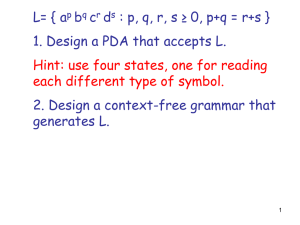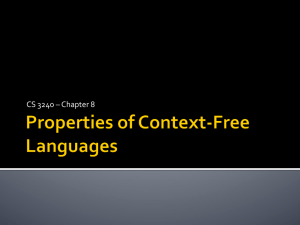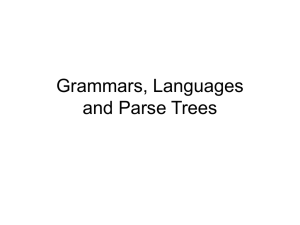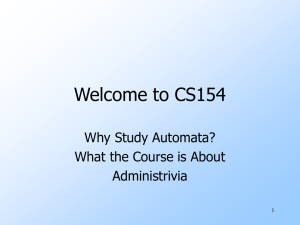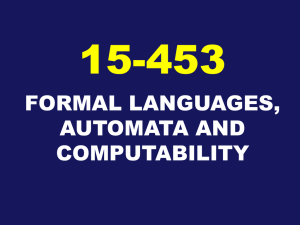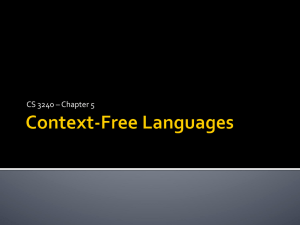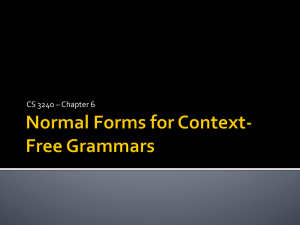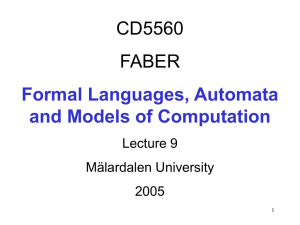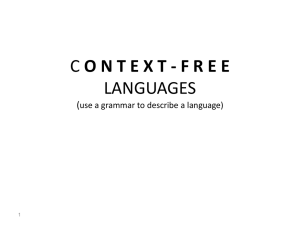L - Winona State University
advertisement
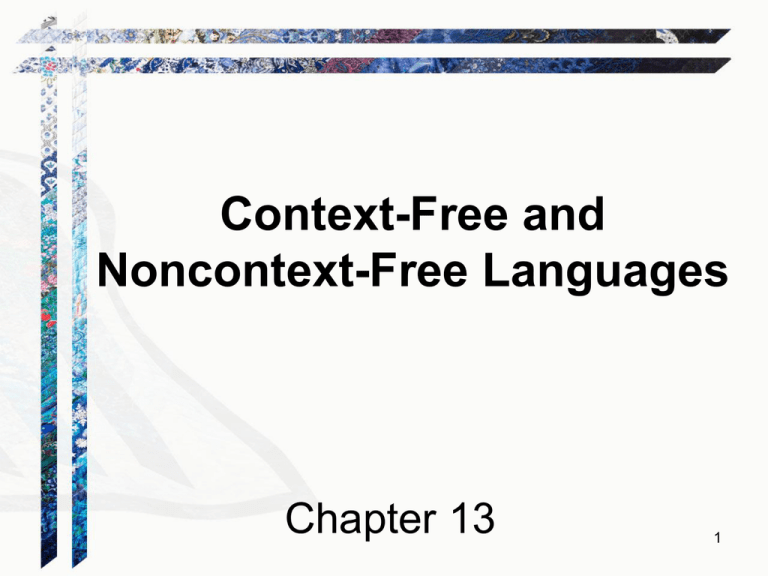
Context-Free and
Noncontext-Free Languages
Chapter 13
1
Languages That Are and
Are Not Context-Free
a*b* is regular.
AnBn = {anbn : n 0} is context-free but not regular.
AnBnCn = {anbncn : n 0} is not context-free.
2
Of Languages and Machines
3
The Regular and the CF Languages
Theorem: The regular languages are a proper subset of
the context-free languages.
Proof: In two parts:
•
Every regular language is CF.
•
There exists at least one language that is CF but not
regular.
4
The Regular and the CF Languages
Lemma: Every regular language is CF.
Proof: Every FSM is (trivially) a PDA:
Given an FSM M = (K, , , s, A) and elements of of the
form: ( p,
c,
q
)
old state, input, new state
Construct a PDA M' = (K, , {}, , s, A). Each (p, c, q)
becomes:
(( p,
c,
),
old state, input, don't
look at
stack
(q,
new state
In other words, we just don’t use the stack.
))
don't
push on
stack
5
There Exists at Least One Language
that is CF but Not Regular
Lemma: There exists at least one language that is CF
but not regular
Proof: {anbn, n 0} is context-free but not regular.
So the regular languages are a proper subset of the
context-free languages.
6
How Many Context-Free Languages Are There?
Theorem: There is a countably infinite number of CFLs.
Proof:
● Upper bound: we can lexicographically enumerate
all the CFGs.
● Lower bound: {a}, {aa}, {aaa}, … are all CFLs.
7
How Many Context-Free Languages Are There?
There is an uncountable number of languages.
Thus there are more languages than there are contextfree languages.
So there must exist some languages that are not
context-free.
Example: {anbncn : n 0}
8
Showing that L is Context-Free
Techniques for showing that a language L is context-free:
1. Exhibit a context-free grammar for L.
2. Exhibit a PDA for L.
3. Use the closure properties of context-free languages.
Unfortunately, these are weaker than they are for
regular languages.
9
Showing that L is Not Context-Free
Remember the pumping argument for regular
languages:
10
A Review of Parse Trees
A parse tree, derived by a grammar G = (V, , R, S), is a
rooted, ordered tree in which:
● Every leaf node is labeled with an element of {},
● The root node is labeled S,
● Every other node is labeled with some element of V - ,
● If m is a nonleaf node labeled X and the children of m
are labeled x1, x2, …, xn, then the rule X x1, x2, …, xn
is in R.
11
Some Tree Basics
The height of a tree is the length of the longest path from the root to
any leaf.
The branching factor of a tree is the largest number of daughter
nodes associated with any node in the tree.
Theorem: The length of the yield of any tree T with height h and
branching factor b is bh.
number of leaf nodes
12
From Grammars to Trees
Given a context-free grammar G:
● Let n be the number of nonterminal symbols in G.
● Let b be the branching factor of G
Suppose that T is generated by G and no nonterminal appears more
than once on any path:
The maximum height of T is:
The maximum length of T’s yield is:
13
The Context-Free Pumping Theorem
This time we use parse trees, not automata as the basis for our
argument.
If w is “long”, then its parse trees must look like:
Choose one such tree such that there’s no other with fewer nodes.
14
The Context-Free Pumping Theorem
There is another derivation in G:
S * uXz * uxz,
in which, at the point labeled [1], the nonrecursive rule2 is used.
So uxz is also in L(G).
15
The Context-Free Pumping Theorem
There are infinitely many derivations in G, such as:
S * uXz * uvXyz * uvvXyyz * uvvxyyz
Those derivations produce the strings:
uv2xy2z, uv3xy3z, …
So all of those strings are also in L(G).
16
The Context-Free Pumping Theorem
If rule1 = X Xa, we could get v = .
If rule1 = X aX, we could get y = .
But it is not possible that both v and y are . If they were, then the
derivation S * uXz * uxz would also yield w and it would create
a parse tree with fewer nodes. But that contradicts the assumption
that we started with a tree with the smallest possible number of 17
nodes.
The Context-Free Pumping Theorem
The height of the subtree rooted at [1] is at most:
18
The Context-Free Pumping Theorem
The height of the subtree rooted at [1] is at most: n + 1
So |vxy| bn + 1.
19
The Context-Free Pumping Theorem
If L is a context-free language, then
k 1
( strings w L, where |w| k
(u, v, x, y, z (w = uvxyz,
vy ,
|vxy| k and
q 0 (uvqxyqz is in L)))).
20
What Is k?
k serves two roles:
● How long must w be to guarantee it is pumpable?
● What’s the bound on |vxy|?
Let n be the number of nonterminals in G.
Let b be the branching factor of G.
21
How Long Must w be?
If height(T) > n, then some nonterminal occurs more than once on
some path. So T is pumpable.
If height(T) n, then |uvxyz| bn.
So if |uvxyz| > bn, w = uvxyz must be pumpable.
22
What’s the Bound on |vxy|?
Assume that we are considering the bottom-most two instances of a
repeated nonterminal. Then the yield of the upper one has length
at most bn+1.
Assuming b 2, bn+1 > bn.
23
So let k =
bn+1.
The Context-Free Pumping Theorem
If L is a context-free language, then k 1, such that
strings w L, where |w| k,
u, v, x, y, z, such that:
w = uvxyz,and
vy , and
|vxy| k, and
q 0, uvqxyqz is in L.
Proof: L is generated by some CFG G = (V, , R, S) with n nonterminal
symbols and branching factor b. Let k be bn + 1. The longest string that
can be generated by G with no repeated nonterminals in the resulting
parse tree has length bn. Assuming that b 2, it must be the case that
bn + 1 > bn. So let w be any string in L(G) where |w| k. Let T be any
smallest parse tree for w. T must have height at least n + 1. Choose
some path in T of length at least n + 1. Let X be the bottom-most repeated
nonterminal along that path. Then w can be rewritten as uvxyz. The tree
rooted at [1] has height at most n + 1. Thus its yield, vxy, has length less
than or equal to bn + 1, which is k. vy since if vy were then there
would be a smaller parse tree for w and we chose T so that that wasn’t so.
uxz must be in L because rule2 could have been used immediately at [1].
For any q 1, uvqxyqz must be in L because rule1 could have been used q
times before finally using rule2.
24
Regular vs CF Pumping Theorems
Similarities:
● We choose w, the string to be pumped.
● We choose a value for q that shows that w isn’t pumpable.
● We may apply closure theorems before we start.
Differences:
● Two regions, v and y, must be pumped in tandem.
● We don’t know anything about where in the strings v and y will
fall. All we know is that they are reasonably “close together”, i.e.,
|vxy| k.
● Either v or y could be empty, although not both.
25
An Example of Pumping: AnBnCn
AnBnCn = {anbncn, n 0}
26
An Example of Pumping: AnBnCn
AnBnCn = {anbncn, n 0}
Choose w = ak bk ck
1|2|3
27
An Example of Pumping: AnBnCn
AnBnCn = {anbncn, n 0}
Choose w = ak bk ck
1|2|3
If either v or y spans regions, then let q = 2 (i.e., pump in once).
The resulting string will have letters out of order and thus not
be in AnBnCn.
If both v and y each contain only one distinct character then set
q to 2. Additional copies of at most two different characters
are added, leaving the third unchanged. There are no longer
equal numbers of the three letters, so the resulting string is
not in AnBnCn.
28
An Example of Pumping: {a , n 0}
n2
n2
L = { a , n 0}
The elements of L:
n
w
1
a1
2
a4
3
a9
4
a16
5
a25
6
a36
0
29
An Example of Pumping: {a , n 0}
n2
n2
L = { a , n 0}
4
If n = k2, then n2 = k4. Let w = a k .
30
An Example of Pumping: { a : n 0}
n2
n2
L = { a , n 0}.
If n =
k 2,
then
n2
=
k 4.
k4
Let w = a .
vy = ap, for some nonzero p.
Set q to 2. The resulting string, s, is
isn’t because it is too short:
w:
(k2)2 a’s
k4 a’s
a
k4 p
. It must be in L. But it
next longer string in L:
(k2 + 1)2 a’s
k4 + 2k2 + 1 a’s
For s to be in L, p = |vy| would have to be at least 2k2 + 1.
But |vxy| k, so p can’t be that large. Thus s is not in L and L is not
context-free.
31
Another Example of Pumping
L = {anbman, n, m 0 and n m}.
Let w =
32
Another Example of Pumping
L = {anbman, n, m 0 and n m}.
Let w = akbkak
aaa … aaabbb … bbbaaa … aaa
|
1
|
2
|
3
|
33
Nested and Cross-Serial Dependencies
PalEven = {wwR : w {a, b}*}
a a b b a a
The dependencies are nested.
WcW = {wcw : w {a, b}*}
a a b c a a b
Cross-serial dependencies.
34
WcW = {wcw : w {a, b}*}
35
WcW = {wcw : w {a, b}*}
Let w = akbkcakbk.
aaa … aaabbb …
|
1
|
2
bbbcaaa … aaabbb … bbb
|3|
4
|
5
|
Call the part before c the left side and the part after c the right side.
● If v or y overlaps region 3, set q to 0. The resulting string will no
longer contain a c.
● If both v and y occur before region 3 or they both occur after
region 3, then set q to 2. One side will be longer than the other.
● If either v or y overlaps region 1, then set q to 2. In order to make
the right side match, something would have to be pumped into
region 4. Violates |vxy| k.
● If either v or y overlaps region 2, then set q to 2. In order to make
the right side match, something would have to be pumped into
region 5. Violates |vxy| k.
36
Variable Declaration and Use
WcW = {wcw : w {a, b}*}.
string winniethepooh;
winniethepooh =
“bearofverylittlebrain”;
37
Closure Theorems for Context-Free Languages
The context-free languages are closed under:
● Union
● Concatenation
● Kleene
star
● Reverse
● Letter
substitution
38
Closure Under Union
Let G1 = (V1, 1, R1, S1), and
G2 = (V2, 2, R2, S2).
Assume that G1 and G2 have disjoint sets of nonterminals,
not including S.
Let L = L(G1) L(G2).
We can show that L is CF by exhibiting a CFG for
it:
39
Closure Under Union
Let G1 = (V1, 1, R1, S1), and
G2 = (V2, 2, R2, S2).
Assume that G1 and G2 have disjoint sets of nonterminals,
not including S.
Let L = L(G1) L(G2).
We can show that L is CF by exhibiting a CFG for
it:
G = (V1 V2 {S}, 1 2,
R1 R2 {S S1, S S2},
S)
40
Closure Under Concatenation
Let G1 = (V1, 1, R1, S1), and
G2 = (V2, 2, R2, S2).
Assume that G1 and G2 have disjoint sets of nonterminals,
not including S.
Let L = L(G1)L(G2).
We can show that L is CF by exhibiting a CFG for it:
41
Closure Under Concatenation
Let G1 = (V1, 1, R1, S1), and
G2 = (V2, 2, R2, S2).
Assume that G1 and G2 have disjoint sets of nonterminals,
not including S.
Let L = L(G1)L(G2).
We can show that L is CF by exhibiting a CFG for it:
G = (V1 V2 {S}, 1 2,
R1 R2 {S S1 S2},
S)
42
Closure Under Kleene Star
Let G = (V, , R, S1).
Assume that G does not have the nonterminal S.
Let L = L(G)*.
We can show that L is CF by exhibiting a CFG for it:
43
Closure Under Kleene Star
Let G = (V, , R, S1).
Assume that G does not have the nonterminal S.
Let L = L(G)*.
We can show that L is CF by exhibiting a CFG for it:
G = (V1 {S}, 1,
R1 {S , S S S1},
S)
44
Closure Under Reverse
LR= {w * : w = xR for some x L}.
Let G = (V, , R, S) be in Chomsky normal form.
Every rule in G is of the form X BC or X a, where X, B, and C are
elements of V - and a .
● X a: L(X) = {a}.
{a}R = {a}.
● X BC: L(X) = L(B)L(C).
(L(B)L(C))R = L(C)RL(B)R.
Construct, from G, a new grammar G, such that L(G) = LR:
G = (VG, G, R, SG), where R is constructed as follows:
● For every rule in G of the form X BC, add to R the rule X CB.
● For every rule in G of the form X a, add to R the rule X a.
45
What About Intersection and Complement?
Closure under complement implies closure under intersection, since:
L1 L2 = (L1 L2)
But are the CFLs closed under either complement or intersection?
We proved closure for regular languages two different ways:
1. Given a DFSM for L, construct a DFSM for L by swapping
accepting and rejecting states. If closed under complement and
union, must be closed under intersection.
2. Given automata for L1 and L2, construct an automaton for L1 L2
by simulating the parallel operation of the two original machines,
using states that are the Cartesian product of the sets of states of
the two original machines.
Does either work here?
46
Closure Under Intersection
The context-free languages are not closed under
intersection:
The proof is by counterexample. Let:
L1 = {anbncm: n, m 0}
L2 = {ambncn: n, m 0}
/* equal a’s and b’s.
/* equal b’s and c’s.
Both L1 and L2 are context-free, since there exist
straightforward context-free grammars for them.
But now consider:
L = L1 L2
=
47
Closure Under Intersection
The context-free languages are not closed under
intersection:
The proof is by counterexample. Let:
L1 = {anbncm: n, m 0}
L2 = {ambncn: n, m 0}
/* equal a’s and b’s.
/* equal b’s and c’s.
Both L1 and L2 are context-free, since there exist
straightforward context-free grammars for them.
But now consider:
L = L1 L2
= {anbncn: n 0}
48
Closure Under Complement
L1 L2 = (L1 L2)
The context-free languages are closed under union, so if
they were closed under complement, they would be
closed under intersection (which they are not).
49
Closure Under Complement
An Example
AnBnCn is context-free:
But (AnBnCn) = AnBnCn is not context-free.
50
Closure Under Difference
Are the context-free languages closed under difference?
51
Closure Under Difference
Are the context-free languages closed under difference?
L = * - L.
* is context-free. So, if the context-free languages
were closed under difference, the complement of
any context-free language would necessarily be
context-free. But we just showed that that is not so.
52
The Intersection of a Context-Free Language
and a Regular Language is Context-Free
L = L(M1), a PDA = (K1, , 1, 1, s1, A1).
R = L(M2), a deterministic FSM = (K2, , , s2, A2).
We construct a new PDA, M3, that accepts L R by simulating the
parallel execution of M1 and M2.
M = (K1 K2, , 1, , (s1, s2), A1 A2).
Insert into :
For each rule ((q1,
a, ), ( p1,
)) in 1,
and each rule ( q2,
a,
p2 )
in ,
((( q1, q2), a, ), (( p1, p2), )).
For each rule ((q1,
, ), (p1,
) in 1,
and each state q2
in K2,
(((q1, q2), , ), ((p1, q2), )).
This works because: we can get away with only one stack.
53
The Difference between a Context-Free Language
and a Regular Language is Context-Free
Theorem: The difference (L1 – L2) between a context-free
language L1 and a regular language L2 is context-free.
Proof: L1 – L2 = L1 L2.
If L2 is regular then so is L2.
If L1 is context-free, so is L1 L2.
54
An Example: A Finite Number of
Exceptions
Let:
L = {anbn: n 0 and n 1776}.
Alternatively:
L = {anbn: n 0} – {a1776b1776}.
{anbn: n 0} is context-free.
{a1776b1776} is regular.
55
Don’t Try to Use Closure Backwards
One Closure Theorem:
If L1 and L2 are context free, then so is
L3 =
L1
L2.
But what if L3 and L1 are context free? What can we say
about L2?
L3 =
L1
L2.
56
Don’t Try to Use Closure Backwards
One Closure Theorem:
If L1 and L2 are context free, then so is
L3 =
L1
L2.
But what if L3 and L1 are context free? What can we say
about L2?
L3 =
Example:
L1
L2.
anbnc* = anbnc* anbncn.
57
Using the Closure Theorems with the
Pumping Theorem
Let WW = {ww : w {a, b}* }.
Let’s try pumping: Choose w = (ab)2k
(Don’t get confused about the two uses of w.)
w
w
ababab…abababababab…ababababab
But this pumps fine with v = and y =
58
Exploiting Regions
WW = {ww : w {a, b}* }.
Choose the string akbakb.
aaaaa…………………baaaaaa……………..b
w
w
But this also pumps fine.
59
Make All Regions “Long”
WW = {ww : w {a, b}* }.
Choose the string akbkakbk.
aaa….. aabb………bbaa……aabb……..b
w
w
1
2
3
4
Now we list the possibilities:
(1, 1), (2, 2), (3, 3), (4, 4), (1, 2), (2, 3), (3, 4), (1, 3), (1, 4),
(2, 4), (1/2, 2), (1/2, 3), (1/2, 4), (1/2, 2/3),…
Whenever v or y spans regions, we’ll no longer have a
string of the same form, but that’s okay given the
definition of L.
60
Using Intersection with a Regular Language
WW = {ww : w {a, b}* }.
Recall our last choice of w: akbkakbk.
aaa….. aabb………bbaa……aabb……..b
w
w
1
2
3
4
But let’s consider L' = L
61
Using Intersection with a Regular Language
WW = {ww : w {a, b}* }.
But let’s consider L' = L a*b*a*b*.
L' is not context-free. Let w = akbkakbk.
aaa….. aabb………bbaa……aabb……..b
w
w
1
2
3
4
62
Another Example
L = {w : w can be written as
x#y=z:
x, y, z {0, 1}* and, if x, y, and z are
viewed as binary numbers without
leading zeros, xy = zR}.
For example, 100#1111=001111 is in L.
63
Another Example
L = {w : w can be written as
x#y=z:
x, y, z {0, 1}* and, if x, y, and z are
viewed as binary numbers without
leading zeros, x # y = zR}.
Choose w = 10k#1k=0k1k:
1 000 … 000 # 111 … 111 = 000 … 000111 …111
|1|
2
|3|
4
|5|
6
|
7
|
Note that w is in L.
If L is CF, so is L = L 10*#1*=0*1*:
64
Another Example
Choose w = 10k#1k=0k1k:
1 000 … 000 # 111 … 111 = 000 … 000111 …111
|1|
2
|3|
4
|5|
6
|
7
|
L = L 10*#1*=0*1* is not CF:
v or y overlaps 1, 3, or 5:
v or y contains the boundary between 6 and 7:
(2, 2), (4, 4), or (2, 4):
(6, 6), (7, 7), or (6, 7):
(4, 6):
(2, 6), (2, 7) or (4, 7):
65
L = {w {a, b, c}* : #a(w) = #b(w) = #c(w) }
If L were context-free, then L = L a*b*c* would also
be context-free.
But L =
So neither is L.
66
Why are the Context-Free Languages Not
Closed under Complement, Intersection and
Subtraction But the Regular Languages Are?
Given an NDFSM M1, build an FSM M2 such that
L(M2) = L(M1):
1. From M1, construct an equivalent deterministic FSM M,
using ndfsmtodfsm.
2. If M is described with an implied dead state, add the dead state
and all required transitions to it.
3. Begin building M2 by setting it equal to M. Then swap the
accepting and the nonaccepting states. So:
M2 = (KM, , M, sM, KM - AM).
We could do the same thing for CF languages if we could do step 1,
but we can’t.
The need for nondeterminism is the key.
67
